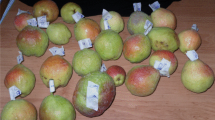Abstract
Thirty one pears genotypes from east blacksea region were evaluated for genetic relationships by using Randomly Amplified Polymorphic DNA (RAPD) and ISSR (Inter-Simple Sequence Repeats) markers from total 70 RAPD and ISSR primer investigated, 22 could amplify clearly and consistently. Cluster analysis of the pears genotypes was performed based on data from polymorphic bands RAPD and ISSR by using Jaccard’s similarity coefficient and the Unweighted pair-group method with arithmetic average (UPGMA) clustering method. The 31 pear genotypes were classified into two major groups. Cluster A was divided into 2 subclusters: Gumushane pears and Trabzon pears. Cluster B consisted of Artvin pears. The similarity matrix values ranged between 0.105 and 0.968.
Zusammenfassung
Bei 31 Birnen-Genotypen aus der Ost-Schwarzmeerregion wurde die genetische Verwandtschaft mit Hilfe der RAPD- (Randomly Amplified Polymorphic DNA) und ISSR-Markern (Inter-Simple Sequence Repeats) bestimmt. Von insgesamt 70 überprüften RAPD- und ISSR-Primern führten 22 zu einem eindeutigen und einheitlichen Ergebnis. Mit den Daten der RAPD- und der ISSR-Methode wurde eine Clusteranalyse zu den Birnen-Genotypen durchgeführt (Jaccard Koeefizient und Unweighted pair-group method with arithmetic average (kurz UPGMA)). Die 31 Birnen-Genotypen wurden in zwei Hauptgruppen eingeteilt. Gruppe A wurde in zwei Untergruppen unterteilt, in Birnen aus Gumushane und Birnen aus Trabzon. Die Birnen aus Artvin befanden sich in Gruppe B. Das Ähnlichkeitsmaß lag zwischen 0,105 und 0,968.

Similar content being viewed by others
References
Aksu MM, Şahin-Çelik M (2015) Moleküler markörlerin meyve islahında kullanım alanları. Meyve Bilimi/fruit Sci 2(1):49–59
Bailey LH (1917) Pyrus. In: Standard cyclopedia of horticulture, vol V. Macmillan, New York, pp 2865–2878
Bao L, Chen K, Zhang D, Cao Y, Yamamoto T, Teng Y (2007) Genetic diversity and similarity of pear (Pyrus L.) cultivars native to East Asia revealed by SSR (simple sequence repeat) markers. Genet Resour Crop Evol 54 doi:10.1007/s10722-006-9152-y
Erdoğan V, Aygün A, San B, Koltarla A, Günes N, Dumanoğlu H (2007) Ankara’ armudu (Pyrus communis L.) klonlarının RAPD tekniği ile moleküler analizi. V. Ulusal Bahçe Bitkileri Kongresi Cilt 1: Meyvecilik, Türkiye, 04–07 Eylül 2007., pp 56–59
Güleryüz M (1979) Özel Meyvecilik Ders Notları. Atatürk Üniversitesi Ziraat Fakültesi, Erzurum
Jaccard P (1908) Nouvelles recherches sur la distribution florale. Bull Soc Vaudoise C. Sci Nat 44:223–270
Kafkas S, Özgen M, Doğan B, Ercişli S, Serce S (2008) Molecular characterization of mulberry accessions in Turkey by AFLP markers. J Am Soc Hortic Sci 133(4):593–597
Özbek S (1978) Özel Meyvecilik (Kışın Yaprağını Döken Meyve Türleri) vol. 128. Çukurova Üniversitesi Ziraat Fakültesi Yayınları, Adana, p Ders kitabı: 11
Pavlovic N, Zdravkovic J, Cvikic C, Zdravkovic M, Adzic S, Pavlovic S, Surlan-Momirovic G (2012) Characterization of onion genotypes by use of RAPD markers. Genetika 44(2):269–278
Queiroz A, Assunçao A, Ramadas I, Viegas W, Veloso MM (2015) Molecular characterization of Portuguese pear landraces (Pyrus communis L.) using SSR markers. Sci Hortic 183:72–76
Rana JC, Chahota RK, Sharma V, Rana M, Verma N, Verma B, Sharma TR (2015) Genetic diversity and structure of Pyrus accessions of Indian Himalayan region based on morphological and SSR markers. Tree Genet Genome 11(821):2–14
Sisko M, Javornik B, Siftar A, Ivancic A (2009) Genetic relationships among Slovenian pears assessed y molecular markers. J Am Soc Hortic Sci 134(1):97–108
Song Y, Fan L, Chen H, Zhang M, Ma Q, Zhang S, Wu J (2014) Identifying genetic diversity and a preliminary core collection of Pyrus pyrifolia cultivars by a genome-wide set of SSR markers. Genet Resour Crop Evol 54(5):959–971
Ünal A (2011) Bahçe Tarımı-II vol. Ünite (1,2). T.C. Anadolu Üniversitesi, Açık Öğretim Fakültesi Yayını, Eskisehir, pp 1–258
Wolko LAWLEBJ, Wolko LAWLEBJ, Wolko LAWLEBJ, Wolko LAWLEBJ (2010) Genetic diversity of European pear cultivars (Pyrus communis L.) and wild pear (Pyrus pyraster L. Burgsd.) inferred from microsatellite markers analysis. Genet Resour Crop Evol 2010(57):801–806
Author information
Authors and Affiliations
Corresponding author
Rights and permissions
About this article
Cite this article
Kalkışım, O., Okcu, M., Okcu, Z. et al. Relationships Among some Pears Genotypes (Pyrus Communis L.) Based on ISSR and RAPD Analysis. Erwerbs-Obstbau 58, 259–264 (2016). https://doi.org/10.1007/s10341-016-0287-5
Received:
Accepted:
Published:
Issue Date:
DOI: https://doi.org/10.1007/s10341-016-0287-5




